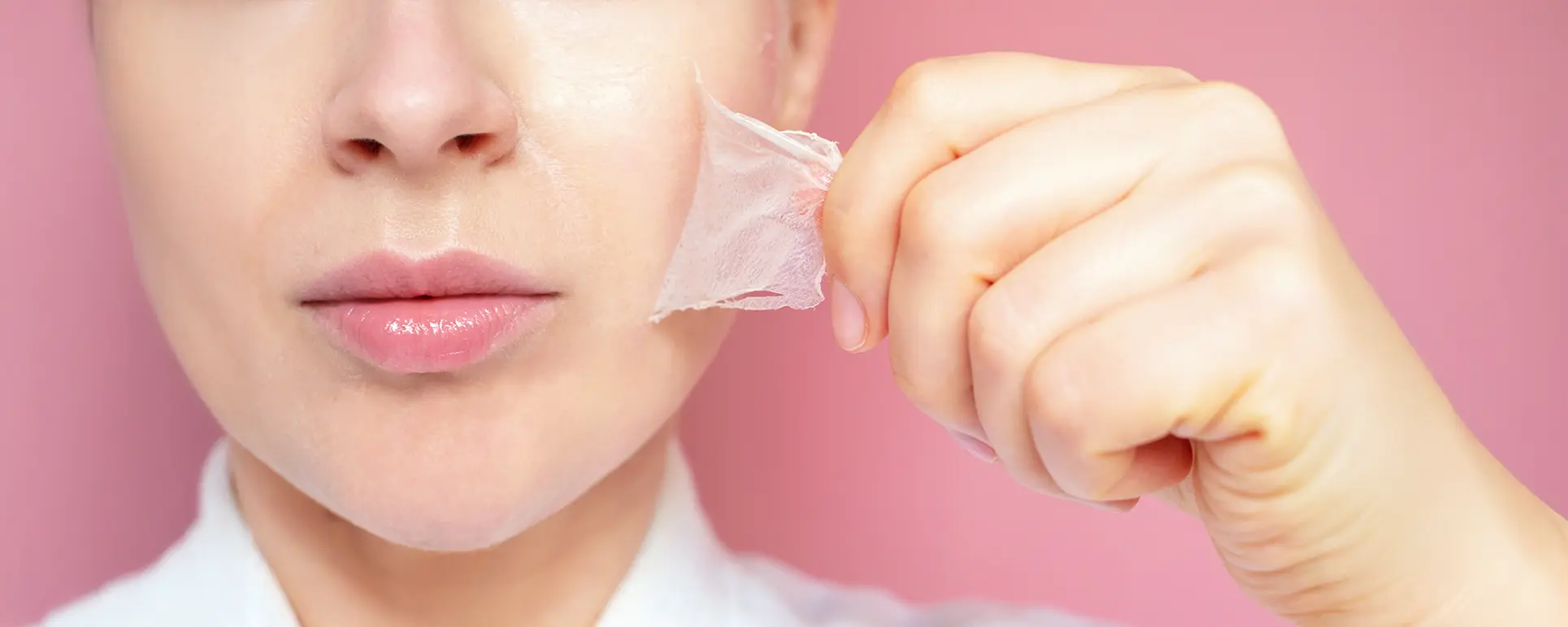Constant skin peeling can be extremely frustrating, uncomfortable, and sometimes even painful. While it’s normal for skin to peel occasionally for example, after sunburn or minor irritation continuous or recurring peeling often indicates an underlying skin condition that requires attention. This persistent peeling can be caused by a variety of factors, including dry skin, eczema, psoriasis, fungal infections, allergic reactions, or other dermatological issues. Ignoring the problem can sometimes make it worse, so early consultation with a dermatologist is highly recommended.
Dermatologists are trained to carefully examine the skin, identify the root cause of the peeling, and provide targeted treatments. They may begin with a detailed medical history and a physical examination, sometimes supplemented by lab tests or skin biopsies, to determine the specific trigger. Based on the diagnosis, treatments can vary widely from prescribing specialized moisturizers and topical medications to recommending lifestyle adjustments and avoiding irritants. In some cases, oral medications or therapies may be necessary to address more severe conditions.
Additionally, dermatologists often educate patients on proper skin care routines to prevent further peeling and promote skin healing. This can include guidance on gentle cleansing, avoiding harsh chemicals, using sunscreen, and maintaining proper hydration. By addressing both the symptoms and the underlying causes, dermatologists help patients restore healthy, smooth skin and reduce the recurrence of constant peeling.
1. Common Causes of Constant Peeling

Eczema (Atopic Dermatitis): Eczema is a chronic inflammatory skin condition that leads to red, itchy, and dry patches. The affected areas often become flaky and peel continuously if left untreated. Triggers for eczema can include environmental allergens, stress, extreme weather conditions, or irritants like harsh soaps and detergents. Without consistent care, such as moisturizing, topical steroid creams, or prescribed medications, the peeling can worsen and even lead to small cracks or secondary infections.
Fungal Infections: Fungal infections like athlete’s foot, ringworm, or yeast infections can irritate the skin, resulting in ongoing peeling. These infections thrive in warm, moist environments, causing redness, itching, scaling, and sometimes a burning sensation. Persistent fungal infections can spread to other parts of the body and may become difficult to treat without antifungal creams, oral medications, or proper hygiene measures.
Psoriasis: Psoriasis is an autoimmune disorder where the skin produces new cells at an accelerated rate, forming thick, scaly patches that often peel. Commonly affected areas include the scalp, elbows, knees, and nails. Triggers can include stress, infections, medications, or hormonal changes. Untreated psoriasis can cause chronic flaking, discomfort, and sometimes cracking or bleeding of the skin. Dermatologists often prescribe topical treatments, phototherapy, or systemic medications for long-term management.
Sun Damage or Chemical Irritation: Overexposure to the sun’s UV rays can damage skin cells, leading to peeling as the skin attempts to repair itself. Similarly, contact with harsh chemicals, cleaning agents, or unsuitable skincare products can irritate the skin’s protective barrier. Repeated exposure can cause chronic peeling, redness, sensitivity, and even increase the risk of long-term skin damage, including premature aging or pigmentation changes.
Dry Skin or Harsh Skincare Routines: Excessively dry skin or overuse of exfoliating products can strip the skin of natural oils, leading to constant peeling. Frequent hot showers, harsh soaps, alcohol-based toners, or incorrect moisturizers can exacerbate dryness. Over time, this weakens the skin’s natural barrier, making it more prone to flaking, cracking, and irritation.
Allergic Reactions: Allergic reactions to skincare products, cosmetics, detergents, or even certain foods can trigger inflammation, redness, itching, and peeling. The peeling may persist until the allergen is identified and completely avoided. Dermatologists may recommend patch testing to determine the exact cause of the reaction.
Nutritional Deficiencies: Deficiencies in essential nutrients like vitamin A, vitamin C, zinc, or omega-3 fatty acids can impact skin health, causing dryness, fragility, and peeling. Proper nutrition is essential to maintain the skin’s hydration, elasticity, and repair mechanisms. Supplements or dietary changes may be advised by a healthcare professional to support healing.
Underlying Medical Conditions: Chronic peeling may also be linked to systemic health issues such as diabetes, thyroid disorders, or autoimmune diseases. These conditions can impair the skin’s natural repair processes, making it more vulnerable to dryness, peeling, and infections. Addressing the underlying medical condition is often necessary to resolve persistent skin issues.
Environmental Factors: Harsh weather conditions, such as extreme cold, low humidity, or excessive wind, can dry out the skin and cause it to peel. Indoor heating and air conditioning can also reduce skin moisture, leading to flaking and irritation over time.
Medication Side Effects: Certain medications, including retinoids, chemotherapy drugs, or antibiotics, can cause peeling as a side effect. Dermatologists may adjust dosages, recommend protective creams, or suggest alternative treatments to manage this symptom.
Excessive Sunburn: Severe sunburn damages the top layer of skin, triggering peeling as part of the natural healing process. Repeated sunburns not only worsen peeling but can also increase the risk of premature aging, pigmentation changes, and skin cancer. Proper sun protection is critical to prevent chronic peeling caused by sun damage.
2. How Dermatologists Diagnose the Cause

Medical History & Physical Examination: The first step a dermatologist takes is a comprehensive review of your medical history. This includes asking about your lifestyle, daily habits, diet, skincare routines, and any previous skin conditions or allergies. They also inquire about the onset, frequency, and pattern of the peeling, as well as associated symptoms like redness, itching, burning, or pain. A careful physical examination of the affected areas allows the dermatologist to assess the type, thickness, and distribution of peeling. Observing these patterns often provides important clues about whether the peeling is caused by dryness, infection, inflammation, or another underlying condition.
Skin Scrapings or Swabs: If an infection is suspected, dermatologists may collect skin scrapings or swabs from the peeling area. These samples are then sent to a laboratory to identify bacterial, fungal, or yeast infections. Accurate identification of the microorganism is crucial, as it ensures that the appropriate antifungal or antibacterial treatment is prescribed. Without proper testing, using the wrong treatment can worsen the condition or prolong peeling. In some cases, cultures may take several days to yield results, so dermatologists may recommend interim care to manage discomfort.
Patch Tests for Allergies: Persistent peeling can sometimes be caused by allergic reactions to skincare products, detergents, metals, or other environmental factors. Dermatologists use patch tests to detect sensitivities by applying small amounts of common allergens to the skin, usually on the back or arm. These patches are monitored over several days to see if a reaction occurs. Identifying the allergen allows patients to avoid triggers, significantly reducing peeling and irritation over time.
Blood Tests and Laboratory Investigations: When systemic issues are suspected, dermatologists may order blood tests to uncover underlying health conditions. These tests can reveal nutritional deficiencies, hormonal imbalances, thyroid disorders, autoimmune diseases, or other metabolic issues that may impact skin health. By addressing the root cause, rather than just the symptoms, dermatologists can create a more effective and long-term treatment plan.
Additional Diagnostic Tools: In some cases, dermatologists may also use a skin biopsy, dermoscopy, or imaging tools to get a closer look at the skin’s structure. This is particularly useful when peeling is accompanied by unusual growths, discoloration, or persistent inflammation that does not respond to standard treatments.
By combining these diagnostic methods, dermatologists can accurately identify the cause of constant peeling and design a personalized treatment plan. This approach ensures that patients not only find relief from discomfort but also restore the skin’s natural barrier and prevent future episodes.
3. Treatment Options

Topical Medications: One of the first approaches dermatologists use to treat constant skin peeling is topical medications. For inflammatory skin conditions like eczema or psoriasis, steroid creams or anti-inflammatory ointments help reduce redness, swelling, and irritation, allowing the skin to repair itself. In cases where peeling is caused by fungal or bacterial infections, antifungal or antibacterial creams are prescribed to directly target the underlying infection. These treatments are generally applied to the affected areas once or twice daily and can show improvement within a few days to weeks, depending on the severity of the condition. For some patients, dermatologists may recommend combination creams that include both antifungal and anti-inflammatory ingredients to address multiple causes at once.
Moisturizers & Emollients: Maintaining proper skin hydration is crucial for healing peeling skin. Dermatologists emphasize the use of high-quality moisturizers and emollients to restore the skin’s natural barrier, lock in moisture, and reduce dryness and flakiness. Thick, fragrance-free creams, ointments, or balms are often preferred, especially for sensitive or severely dry skin. Applying these products immediately after bathing, when the skin is slightly damp, maximizes absorption and effectiveness. Some dermatologists also recommend using overnight emollient therapy or wearing cotton gloves and socks after applying creams to enhance hydration in severely affected areas.
Prescription Treatments: For more severe or persistent cases of skin peeling, dermatologists may prescribe stronger treatments. This can include high-potency steroid creams, calcineurin inhibitors, or other prescription ointments designed to reduce inflammation and speed up healing. In cases of widespread peeling or chronic skin conditions, systemic treatments such as oral medications or biologics may be recommended. These medications work internally to address the root causes, such as autoimmune reactions or severe inflammation, providing long-term relief and preventing recurrences. Regular follow-up appointments ensure that the treatment is effective and any side effects are monitored.
Lifestyle & Skincare Adjustments: Alongside medications, proper lifestyle and skincare habits are essential for managing constant peeling. Avoiding harsh soaps, alcohol-based toners, and hot showers prevents further irritation. Limiting sun exposure and using broad-spectrum sunscreen protects the skin from UV damage, which can worsen peeling. Dermatologists also recommend gentle skincare routines, such as mild cleansing, minimal exfoliation, and regular moisturization, to maintain the skin’s protective barrier. Choosing hypoallergenic and fragrance-free products further reduces the risk of irritation.
Additional Supportive Measures: Depending on the cause of peeling, dermatologists may suggest other supportive strategies. These can include keeping affected areas clean and dry, wearing soft, breathable fabrics to reduce friction, and maintaining proper hydration through water intake. A balanced diet rich in vitamins, antioxidants, and omega-3 fatty acids can improve skin resilience and healing. In some cases, phototherapy (light-based treatments) or specialized dermatological procedures may be recommended to accelerate skin repair, particularly for conditions like psoriasis or chronic eczema.
Ongoing Monitoring & Prevention: Dermatologists emphasize that treating constant peeling is not just about immediate relief but also preventing recurrence. Regular check-ups allow adjustments to medications, skincare routines, and lifestyle habits based on progress. Patients are often advised to track triggers such as stress, environmental changes, or diet to help prevent future flare-ups. By combining medical treatments, proper skincare, lifestyle adjustments, and ongoing monitoring, dermatologists can help patients achieve long-lasting relief and restore healthy, smooth skin.
4. Preventive Care and Ongoing Maintenance
Maintain Consistent Hydration for Skin: Hydration is the cornerstone of healthy skin and the first line of defense against constant peeling. Using high-quality moisturizers, ointments, or emollients regularly helps restore the skin’s natural protective barrier and prevents dryness and flaking. Dermatologists often recommend applying moisturizers immediately after bathing, when the skin is slightly damp, to lock in moisture effectively. Drinking plenty of water throughout the day also helps maintain internal hydration, supporting skin elasticity and overall health. Incorporating hydrating serums or oils, such as those containing hyaluronic acid or ceramides, can further improve moisture retention, especially for those with sensitive or chronically dry skin.
Avoid Identified Triggers: During a dermatology assessment, your doctor may identify specific triggers that exacerbate peeling, such as allergens, irritants, environmental factors, or even certain foods. Avoiding these triggers is critical for long-term skin health. For example, if a patient’s peeling is linked to allergic reactions from fragrances or metals, switching to hypoallergenic, fragrance-free products and avoiding contact with those allergens can significantly reduce irritation and flaking. Additionally, environmental triggers such as extreme cold, low humidity, or prolonged sun exposure should be minimized to protect the skin barrier.
Use Mild, Fragrance-Free Products: Harsh cleansers, exfoliants, and scented skincare products can strip the skin of its natural oils, aggravating peeling and dryness. Dermatologists advise using gentle, fragrance-free cleansers and moisturizers specifically formulated for sensitive skin. Over-washing or scrubbing the skin should be avoided, as it can worsen peeling and delay the healing process. Products containing soothing ingredients like aloe vera, colloidal oatmeal, or ceramides can help strengthen the skin barrier while reducing irritation.
Follow a Dermatologist’s Advice for Long-Term Skin Health: Preventive care extends beyond daily routines. Following a dermatologist’s guidance including prescribed medications, moisturizers, and protective strategies ensures effective long-term management. Regular check-ups allow dermatologists to monitor your progress, adjust treatments, and address any flare-ups before they worsen. Personalized advice may also include recommendations for phototherapy, specialized creams, or systemic treatments if necessary.
Additional Preventive Measures: Other strategies to protect skin and prevent peeling include wearing soft, breathable fabrics that reduce friction, avoiding tight clothing that can rub irritated areas, and maintaining a balanced diet rich in vitamins, antioxidants, and essential fatty acids. Stress management techniques, adequate sleep, and regular physical activity also contribute to healthy skin function. Sun protection is equally vital; using broad-spectrum sunscreen daily prevents UV-induced peeling and long-term skin damage.
Creating a Sustainable Routine: Consistency is key. Establishing a daily skincare routine that incorporates gentle cleansing, targeted moisturization, and trigger avoidance can help prevent future episodes of peeling. Patients should also be encouraged to track environmental or lifestyle factors that may provoke flare-ups, allowing them to take proactive measures.
By combining proper hydration, avoidance of triggers, gentle skincare, expert dermatological guidance, and a healthy lifestyle, individuals can not only prevent constant skin peeling but also maintain smooth, resilient, and naturally healthy skin over the long term.
Final Thought: Prioritising Your Skin’s Health
Your skin is your body’s first line of defence, and when it starts peeling continuously, it’s more than just a cosmetic concern it’s a sign that something deeper might be going on. Addressing the issue early can prevent discomfort and long-term damage. Continuous peeling is a signal from your skin that it needs care and attention. Consulting a professional ensures accurate diagnosis and effective treatment. You can get in touch with us to book a consultation with one of our expert dermatologists in London for personalised care and guidance.
References:
- Cunliffe, W.J. & Kligman, A.M., 2016. Seborrheic dermatitis and dandruff: a comprehensive review. Journal of Dermatological Science, [online] Available at: https://pmc.ncbi.nlm.nih.gov/articles/PMC4852869/
- Santhanam, A., et al., 2025. Chronic hand eczema: a narrative review. Expert Review of Clinical Immunology, [online] Available at: https://pmc.ncbi.nlm.nih.gov/articles/PMC11971080/
- Thomas, N., et al., 2020. The role of moisturizers in addressing various kinds of dermatitis. Dermatology and Therapy, [online] Available at: https://pmc.ncbi.nlm.nih.gov/articles/PMC5849435/
- Kantor, R. & Silverberg, J.I., 2024. Eczema – management and treatment protocols. StatPearls [Internet], [online] Available at: https://www.ncbi.nlm.nih.gov/books/NBK538209/
- Wikipedia contributors, 2025. Pimecrolimus. Wikipedia, [online] Available at: https://en.wikipedia.org/wiki/Pimecrolimus
